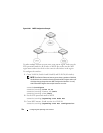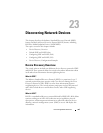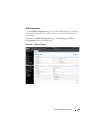
762 Discovering Network Devices
LLDP is a one-way protocol; there are no request/response sequences.
Information is advertised by stations implementing the transmit function,
and is received and processed by stations implementing the receive function.
The transmit and receive functions can be enabled/disabled separately on
each switch port.
What is LLDP-MED?
LLDP-MED is an extension of the LLDP standard. LLDP-MED uses LLDP's
organizationally-specific Type- Length-Value (TLV) extensions and defines
new TLVs that make it easier for a VoIP deployment in a wired or wireless
LAN/MAN environment. It also makes mandatory a few optional TLVs from
LLDP and recommends not transmitting some TLVs.
The TLVs only communicate information; these TLVs do not automatically
translate into configuration. An external application may query the MED
MIB and take management actions in configuring functionality.
Why are Device Discovery Protocols Needed?
The device discovery protocols are used primarily in conjunction with
network management tools to provide information about network topology
and configuration, and to help troubleshoot problems that occur on the
network. The discovery protocols can also facilitate inventory management
within a company.
LLDP and the LLDP-MED extension are vendor-neutral discovery protocols
that can discover devices made by numerous vendors. LLDP-MED is
intended to be used on ports that connect to VoIP phones. Additional
applications for LLDP-MED include device location (including for
Emergency Call Service/E911) and Power over Ethernet management.
ISDP interoperates with the Cisco-proprietary CDP protocol and is most
effective in an environment that contains many Cisco devices.


















